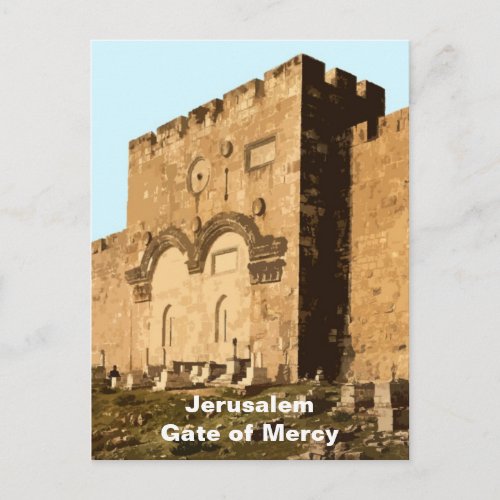Jerusalem - Gate of Mercy Postcard



The Gate of Mercy (Hebrew, Sha'ar Harachamim שער הרחמים) is the oldest of the current gates in Jerusalem's Old City Walls. The gate is located in the middle of the eastern side of the Temple Mount. The gate is divided into two gates, both blocked today with bricks. The northern gate is called is called the 'Gate of Grace' and the southern gate is called the 'Gate of Mercy'. According to Jewish tradition, the Shekhinah (שכינה) (Divine Presence) used to appear through this gate, and will appear again when the Messiah comes (Ezekiel 44:1–3) and a new gate replaces the present one; that is why Jews used to pray for mercy at the former gate at this location. Hence the name. The gate is one of the few sealed gates in Jerusalem's Old City Walls. Unlike most of Jerusalem's other gates, the Golden Gate was originally built at least a millennium before Suleiman the Magnificent rebuilt the walls of Jerusalem in 1540. Some archeologists believe that the original gate, dating back to Herod's construction or even Nehemiah's period (440 BCE), still exists beneath the current gate. Suleiman sealed the gate in 1541 to prevent the Messiah's entrance. Muslims also built a cemetery in front of the gate, in the belief that the precursor to the Messiah, Elijah, would not be able to pass through the gate and thus the Messiah would not come. Hebrew writing on the internal walls of the gate's chamber is believed to have been left by Jewish pilgrims at least 1,000 years ago.The present one was probably built in the 520s AD, as part of Justinian I's building program in Jerusalem, on top of the ruins of the earlier gate in the wall. An alternate theory holds that it was built in the later part of the 7th century by Byzantine artisans employed by the Umayyad khalifs. The Gate of Mercy has special significance on Yom Kippurt. If the gate were opened, it would lead directly onto the Temple Plaza. The outside of the gate would open to the Kidron Valley and the Mount of Olives beyond. In Talmudic literature the gate was also known as the Shushan Gate because of its eastern direction (toward the Persian city of Shushan) and perhaps because of the role played by the Persian leader Cyrus in the Jews' return to Jerusalem after the Babylonian exile. According to tradition, on Yom Kippur a messenger (usually a priest) took the sacrificial lamb from the Temple through the gate to the desert. The Red Heifer purification ceremony also involved taking the sacrifice through the eastern gate to the Mount of Olives.


